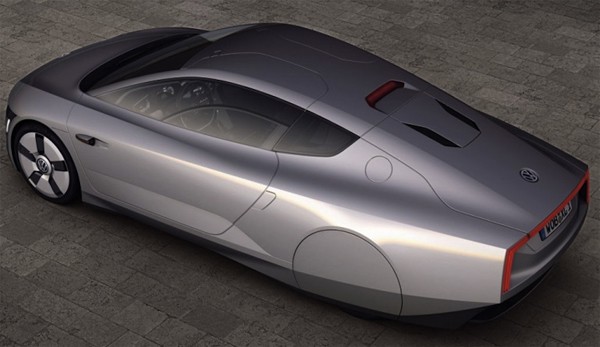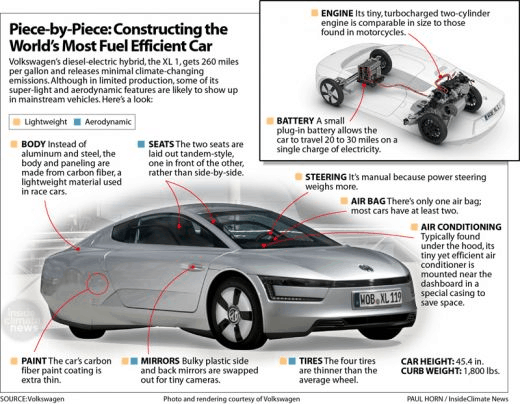By: Amanda Froelich,
Zooming around the United States, there are currently about 161,000 electric vehicles and plug-in hybrids. However this amount is less than 1% of total cars on the road. While initiative to ‘go green’ remains strong in the States, it’s Europe that is unleashing wilder models to ‘wow’ the public and inspire diesel-electric transformation. The new model, which may be considered the world’s most fuel-efficient car, has recently debuted on dealer lots in Germany and Austria. However, consumers should not expect for it to be sold anytime soon.

The Volkswagen XL 1, a diesel-electric hybrid, gets about 260 mpg; this means a New York-to-Washington run would guzzle only about one gallon of diesel.
In comparison, Chevrolet’s all-electric Spark, America’s fuel-economy leader, only gets half of that many miles per gallon. And the average US car gets near 36 mpg.
The XL 1’s low carbon footprint also beats most car models – releasing only 34 grams of carbon dioxide for each mile driven. The typical US car spews almost 10 times that amount into the air while being driven.
The XL 1 may be a limited production vehicle, but it is expected to boost technology development for super-efficient cars as regulations require automakers to address global warming. In April, the quaint two-seater was honored as a finalist in the 2014 World Green Car Competition.
Said Luke Tonachel, senior vehicle analyst at the Natural Resources Defense Council, “The car offers a glimpse into the future. [It’s] technology and innovation will work their way into mainstream vehicles.”
Volkswagen will be selling 250 models, each costing about $150,000. Already about 50 have been sold.
This car is one of a handful of diesel-electric hybrid cars that have been spotlighted on the European market in the last few years.
The United States has not released, nor is planning, any diesel-hybrids, even though regular diesel cars haven’t quite overcome their decades-old baggage of being dirty polluters. How do the two compare? Less than five percent of U.S. Vehicles are diesel-powered compared to about half of automobiles in Europe.

“The car was never designed for [the U.S.] market,” stated Volkswagen spokesman Mark Gillis. That seems clear: Its side-view mirrors, which were swapped out for cameras, and it’s single air bag don’t comply with United States standards.
This incredibly efficient car and its environmental benefit comes mainly from its hybrid engine, and partly from its light, aerodynamic design. The vehicle weighs only 1,800 pounds, less than half the typical U.S. car. Its tires were also slimmed down and its engine shrunk and turbocharged so it could get more power. Even the body paint is extra thin. Similar to most hybrids, the XL 1 is particularly fuel efficient in stop-and-go or city driving, while its diesel engine excels on highways.
However the fuel-efficiency modifications come with performance drawbacks and creature-comfort sacrifices. For example, the air conditioner is weak, and the diesel engine is noisy at low speeds. The car also cannot go above 99 mph and is slow to reach highway speeds.
How the U.S. Is Changing
Because diesel engines are as much as a third more fuel efficient than gasoline varieties and release minimal global warming gases, such change may soon come to the States.
Until recently, diesel engines emitted dangerous levels of nitrogen oxides (a smog-causing gas) and small particulate matter. However strict air standards in America and Europe in the mid-2000s forced automakers to clean up their tailpipe emissions, and in result now diesel vehicles spew just slightly more pollution than their gas competition.
But in the States, it seems consumer interest has remained low. Obviously it has not helped that diesel costs an average 40 cents more than gasoline. In Europe, diesel is less expensive than gas.
But automakers are hoping to shift this attitude by preparing for U.S. fuel economy standards. According to Alex Schaeffer, executive director of the Maryland-based Diesel Technology Forum, there are more than 40 different diesel models in the United States today, which is a dramatic increase from recent years. “For consumers, there are only going to be more choices, “ Schaeffer said. “We are definitely going to see the [diesel] market grow. To double, maybe triple, it’s current size.”
This all falls in line with the Obama administration’s fuel economy standards. The projection is for automakers to cut the global warming emissions of their average car in more than half by 2025, from 325 grams of CO2 emitted per mile to 144 grams per mile. Under these standards, an automaker’s fleet must get about 55 mpg on average. Europe’s emissions goal is for the average car to emit about 153 mpg of CO2 by 2021; it’s efficiency goal about 65 mpg.
All in all, it’s Volkswagen that has led the clean-diesel transformation and who currently dominates the diesel small car market in both Europe and North America. With the current XL 1 vehicle release, no doubt the public will become even more fired up about environmentally-friendly transportation and strive to reduce their own carbon footprint to better the Earth.
Sources for this article include:


